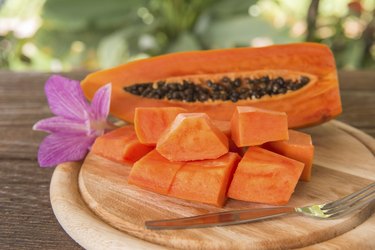
A food allergy to papaya occurs when your immune system mistakenly identifies a protein found in the skin and flesh of the papaya as a threat and creates antibodies in a reaction against it. These antibodies cause your body to exhibit certain symptoms in an attempt to flush out the offending protein. These symptoms can range from mild to life-threatening.
Oral Allergy Syndrome
Video of the Day
Papaya allergy typically occurs as a result of oral allergy syndrome. As the Children's Hospital of Philadelphia explains, oral allergy syndrome occurs when cross-reactivity takes place between plant proteins and the pollen of certain fruits or vegetables. This causes the proteins in those fruits and vegetables to appear similar to the original plant protein. When the immune system has an allergic reaction to a specific plant protein, it may also have a reaction to fruits and vegetables that contain similar proteins. Individuals with a latex allergy may have a cross-reactive allergy to papaya.
Video of the Day
Symptoms
Symptoms typically occur several minutes after eating papaya but may take as long as several hours to appear. According to the Children's Hospital of Philadelphia, oral allergy syndrome "is confined to the lips, mouth and throat." Common symptoms include itching or irritation in the mouth or throat and swelling around the lips. In severe cases, swelling of the throat may also occur, potentially causing breathing difficulties. If you experience throat swelling, seek emergency medical treatment.
Diagnosis
If you suspect you have an allergy to papaya, schedule an appointment with your doctor for an official diagnosis. Provide a detailed history of your symptoms along with a diary of general eating habits. Your doctor will likely perform a skin test. As MayoClinic.com explains, the doctor pricks your skin with a needle and allows a small sample of the suspected substance to seep beneath the skin's surface. He then watches for a bump or other skin reaction. He may also perform a blood test to check for allergy-type antibodies, called immunoglobulin E antibodies. These antibodies are sent by the immune system into the bloodstream whenever an allergic reaction occurs.
Other Potential Triggers
According to Sydney Children's Hospital in Australia, nearly 40 percent of patients with a latex allergy have food allergies to papaya and other fruits. Other common offenders include avocado, banana, passionfruit, melon, mango, kiwi, peach and pineapple. The New York State Department of Health also lists several nonfruit-potential offenders, including carrots, celery, raw potatoes, chestnuts and hazelnuts.
Treatment and Prevention
The best treatment for a papaya allergy is prevention. Avoid eating or coming into contact with papaya as much as possible. Cooking papaya often chemically alters the offending proteins enough to prevent symptoms in individuals with a mild or moderate allergy, but consult your doctor before attempting to consume papaya in any form. If you eat papaya and experience mild symptoms, an over-the-counter antihistamine may reduce your discomfort. If a severe reaction occurs, you may need an injection of epinephrine to stop your symptoms from progressing further.
- Purdue University - Agriculture; Papaya; Julia Morton; 1987
- New York State Department of Health: Latex Allergy
- The Children's Hospital of Philadelphia: Oral Allergy Syndrome
- Sydney Children's Hospital; Fruit and Vegetable Allergy; June 2010
- American College of Allergy, Asthma and Immunology: Latex Allergy
Is this an emergency? If you are experiencing serious medical symptoms, please see the National Library of Medicine’s list of signs you need emergency medical attention or call 911.